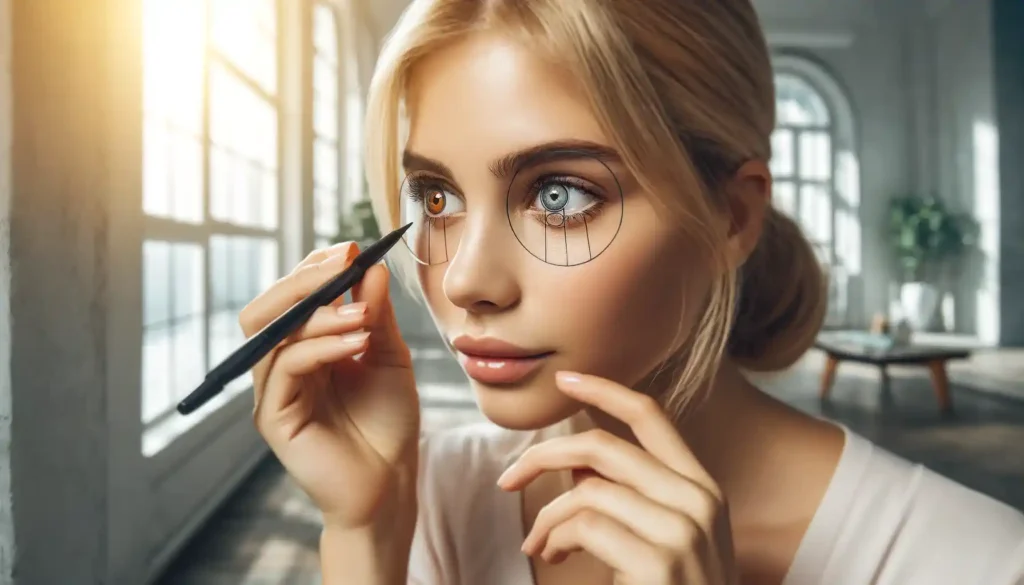How to Recover Eyesight Naturally in 15 Best Techniques. We will review and justify fourteen 15 rules for maintaining eye health. They are very simple and can be followed anytime and anywhere – for example, while walking, standing in line at the store, at work, while driving, and even while reading or watching TV. This will give you pleasure and help keep your vision clear until old age.
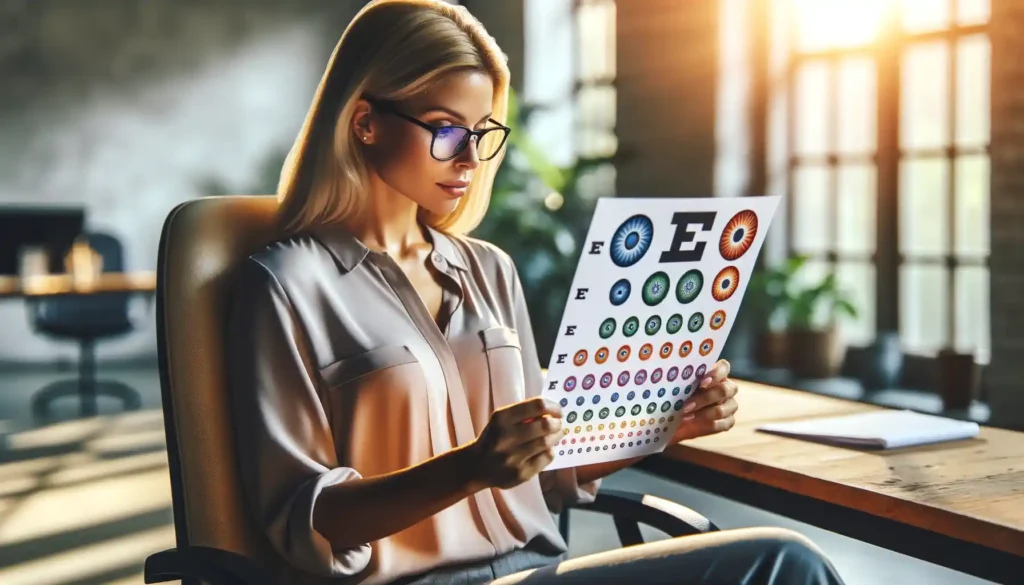
1st Technique: Easing Eye Tension: Natural Ways to Restore Eyesight
Myopia (myopia) develops for two reasons:
1. A person does not focus when looking into the distance, or does it incorrectly.
2. Frequent and prolonged visual work at close range.
Unfortunately, we live in a world of “looking up close.” Reading (books, newspapers, and magazines) and precision work in offices, schools, factories and factories require focusing primarily on nearby objects. In addition, in the 21st century, the need to see clearly and clearly at long distances has practically disappeared. Many people rarely look at objects more than fifteen meters away from them. This led to a general deterioration in distance vision.
Eye Relaxation Techniques for Natural Vision Recovery
Nature intends for us to use vision to look at objects six or more meters away from our eyes. When we look into the distance, the ciliary muscles of the eye relax, because in this case the rays of light penetrate the eyeball in parallel. When we focus on close objects, light rays enter the eyes in a diverging beam. In the second case, in order to focus light directly on the macula of the retina, the ciliary muscles must contract. When muscles remain in a contracted position for a long time, this leads to their spasm and then vision becomes blurry. To visualize this process, hold a dumbbell in your hand and lift it for a few minutes – your fingers and biceps will become tight from the tension. When you lower the dumbbell, it takes a while for you to fully extend your fingers. The biceps will also remain tense and contracted for some time. Likewise, if you are forced to focus on a nearby object for a long time, your eye muscles will become frozen in one position.

Most of us are born with good eyesight, but after attending colleges and universities and spending many years in front of the computer, we are forced to wear glasses. Our health and vision are deteriorating, and our acquired education cannot save us. Therefore, we need such knowledge that will give us a true understanding of how our eyes function and how to improve our vision.
1. Practice looking into the distance
Do you want to have clear and sharp vision? Then you must train your distance vision. You can do this while walking or on your lunch break – look out the window at distant objects located within or slightly beyond your current vision. Focus on objects that are clearly visible to you, and try to achieve even greater clarity within a few seconds. This exercise will help you regain your lost ability to see distant objects.
Practice looking at objects in a relaxed and effortless manner. Avoid tension. It is very important not to look at objects a distance to which significantly exceeds the capabilities of your vision – this is too much strain on the eyes! Read the inscriptions on distant signs, and try to see the license plates of cars passing by. Go birdwatching. Follow the plane flying in the sky with your eyes. Count the stars in the night.
2. Switch to remote sites
This is a very important recommendation to follow when doing close-up visual work, reading, or watching TV. It will help you avoid freezing the eye muscles in a contracted position. All that is required of you is to look at distant objects every five minutes and look at them carefully for five seconds. Ross and Rener, experts in natural vision restoration, advise: “Take your eyes away from what you are doing every five minutes, no matter how exciting or important it may be, and look into the distance for five seconds.” They also recommend continuing to do so after your vision returns to normal.
3. Avoid focusing on nearby objects during and after eating
Dr. Sazaki, a Japanese ophthalmologist, claims that you could add twenty years to your life if you refrained from reading during meals and went for a walk after eating for at least half an hour or an hour. Reading (or other activities that require focusing on close objects) during and immediately after eating impairs vision, since during this period blood rushes down into the digestive system, and, therefore, the eyes do not receive enough nutrition. As a result, the eye muscles become temporarily weakher vision becomes blurred.
An hour’s walk in the fresh air after eating saturates your body with the oxygen necessary for complete digestion and absorption of food and gives the body energy, which has a beneficial effect on your eyes. People need to spend a lot of time in the air, since, having a beneficial effect on the functioning of the kidneys, liver, and eyes, walking significantly improves health and vision. Walking and doing breathing exercises in the fresh air stimulate the production of red blood cells, saturate cells with oxygen, and improve mood, thereby improving health and extending life. Take advantage of fresh air, especially in warm, sunny weather.
Important information. Myopics (nearsighted people) strive to instantly see the entire object, such as a car or building. Farsighted people, who have difficulty seeing close up, try to cover the entire page with their vision at once. Please note: in order to see an object clearly and distinctly, you need to focus on a separate part or fragment of it.
2nd Technique: Relax Your Gaze for Avoiding Eye Strain and to Recover Eyesight Naturally
Eye strain is the main cause of visual impairment. Trying to look at some near or distant object that is difficult for you to see clearly, you overstrains your eye muscles. Just as lifting weights strains the muscles and tendons in your arms, reading small print in poor lighting strains your eyes, which leads to weakened near vision and the development of farsightedness. When you hold text too close to your eyes (at a distance of less than thirty centimeters), read often and for a long time without rest, or try to look at distant objects in detail, you thereby trigger the development of myopia (myopia).
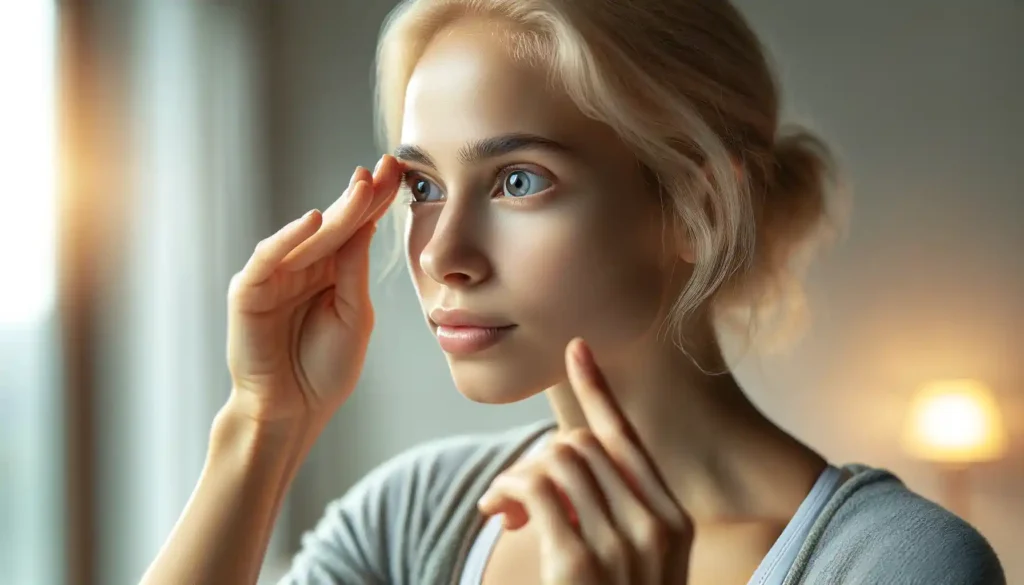
In order not to overload your eyes, you need to:
1. Read in bright light.
2. When reading and working at close range, every couple of minutes, focus on a letter and look at it carefully for five to ten seconds.
If you are unable to see the object clearly, do not force it. Move closer to the subject, turn on more lights, or temporarily wear glasses.
Recover Your Sight Naturally with Eyesight Academy: The Ultimate Course
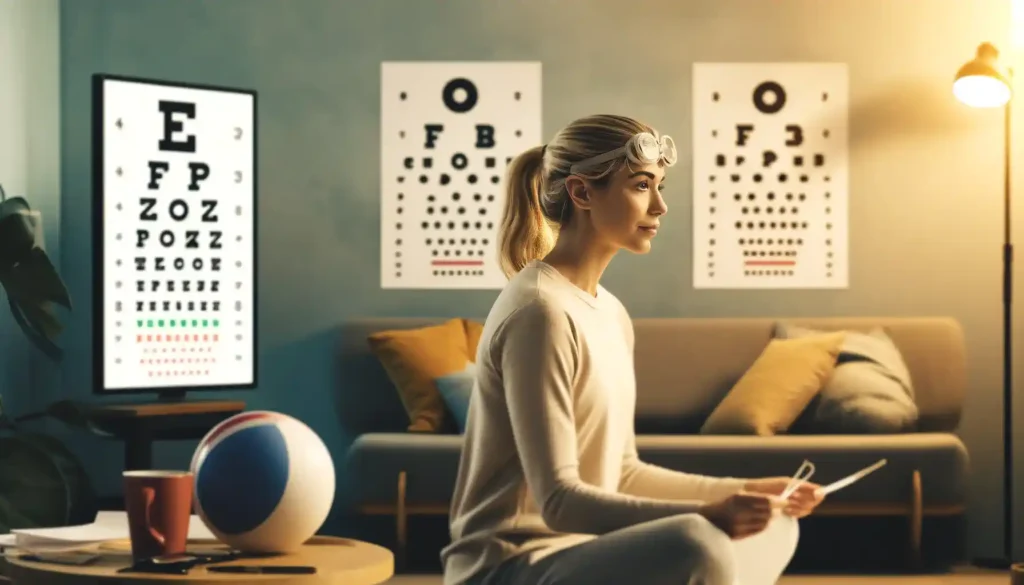
Unlock the Power of Your Vision
Discover the secrets to improving your eyesight naturally with Eyesight Academy, the most comprehensive and transformative course available today. Whether you’re dealing with the strain of daily screen use, the effects of aging, or simply want to maintain your vision’s health, our course offers a holistic path to clearer, sharper sight without relying on glasses or contact lenses.
Expert-Led Techniques
Innovative Learning Approach
Dive into our meticulously designed curriculum, crafted by leading vision care experts. Our modules combine the latest scientific research with traditional practices, ensuring you get a well-rounded approach to eye health.
Personalized Strategies
Eyesight Academy doesn’t believe in a one-size-fits-all solution. Our course includes personalized assessments to tailor your learning and practice strategies, fitting your unique vision needs and lifestyle.
Comprehensive Curriculum
Eye Yoga and Exercises
Learn and master eye yoga techniques and exercises that stimulate your eyes, improve focus, and enhance overall vision health.
Diet and Nutrition
Unlock the power of nutrition for eye health. Our course guides you through the best foods, supplements, and dietary practices to nourish your eyes from the inside out.
Lifestyle Adjustments
Discover how small changes in your daily routine can have a big impact on your vision. We cover everything from proper lighting to screen use, ensuring your eyes are protected and can recover naturally.
Start Your Journey to Better Vision Today
Don’t let poor eyesight dim your view of the world. Enroll in Eyesight Academy and take the first step towards recovering your sight naturally. Experience the freedom of clear vision and the joy of discovering the world in its full splendor. Your eyes deserve it!
Eye Care Essentials: Preventing Strain to Recover Eyesight Naturally
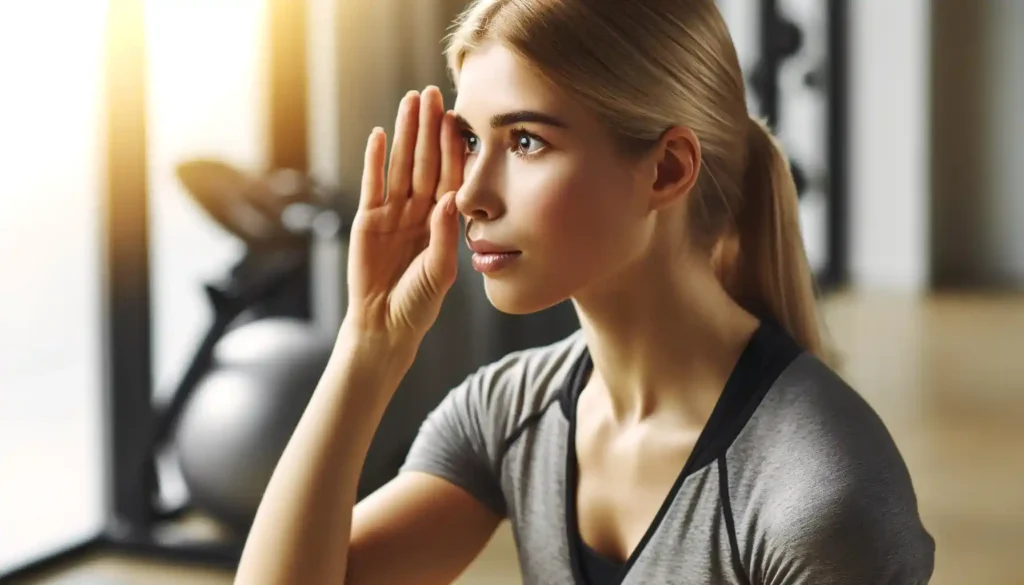
The severe strain on the eyes includes prolonged exposure to cold winds and bright artificial lighting (especially fluorescent lighting). Excessive TV watching also leads to eye fatigue and weakening. To strengthen, heal and relax your tired and stressed eyes, look at the beauty of nature: green trees and grass, mountains, beautiful flowers, flowing rivers, green-blue ocean waters, the sky, stars at night, the moon, sunrise and sunset. Only nature can heal you – with the healing energy of qi flowing from the heavens.
1. Do not read when you are sick or overworked
The body is a dynamic energy system. When it is unhealthy or tired, the eyes are not in the best condition and vision loses clarity.
A decrease in bodily energy reduces the functionality of the entire body, especially the liver, which is directly connected to the eyes by acupuncture meridians. Reading while sick or tired weakens the focusing muscles of the eyes.
Remember your condition when you were sick or in a stressful situation. You may have noticed that during that period your visual acuity was sharply decreasing. As a teenager, I read a lot until late at night when my eyes began to blur, thereby extremely straining and tiring my vision.
As a result, my vision deteriorated. It follows that you can read and do close-up visual work only when you are full of energy. If you feel unwell or overworked, give your body a good night’s sleep and rest.
Important information. The body, brain, and eyes heal and restore during rest and a good night’s sleep. Lack of rest and sleep can easily disrupt the functioning of the liver, gastrointestinal tract, and immune system and have a detrimental effect on vision.
2. Don’t read in dim lighting
Natural sunlight has a power of 10,000 watts. In comparison, indoor lighting, which has a maximum output of 150–200 watts, is very dim. Most people read in 60-100 watt lighting, putting stress and fatigue on their eyes. If you also do not see very well, your eyes strain and weaken much more.
It’s best to read in daylight, with sunlight shining through the window onto your workspace. Better yet, read or work outside, weather permitting. As dusk approaches, work in at least 150 to 200 watts of light to see clearly and reduce eye strain. Light the work surface so that it does not reflect light. Dr. Vogel does not recommend reading before bed or in bed, as this can lead to further deterioration of vision, fatigue, congestion, and insomnia.
3. Watch your posture while reading
Incorrect body position while reading is also one of the main causes of weakened and tired eyes. When you read, do not lower your head or crane your neck. If you sit with your head down while reading, your eyes look down. As a result, pressure on the eyeballs and tension in the external eye muscles, which hold the eyes in the eye sockets, increases. When you sit with your head down, your eyeballs become elongated, and this leads to the development of myopia, or nearsightedness.
4. Keep the text parallel to your face, 50 centimeters from your eyes
Many myopics could improve their vision by following one important rule – keep the text parallel to the eyes, at a distance of fifty centimeters. When the text is too close to the eyes (less than thirty centimeters), it provokes the development of myopia. Looking at young people who read with their noses in a book, I understand that they are confidently moving towards myopia. Dr. Sazaki and many other natural science experts
Improvements in vision do not advise children and adolescents to read too much. In their opinion, when reading you need to look at distant objects as often as possible.
5. Take a break while reading every half hour.
Half an hour is the maximum time when the eyes are able to focus without straining or getting tired. Read during this time, then get up and walk around the room, stretch, or get some fresh air. Look into the distance. Inhale deeply, bend forward, rub your face, forehead and eye area, then exhale and straighten up. Inhale again and bend back, then to both sides, exhale and relax your eyes. Now do the Palming exercise developed by Dr. Bates: close your eyes, cover your eye sockets with your palms and imagine an intensely black object, such as black velvet.
Deep breathing, rubbing the face and head, bending forward, backward and to the sides, as well as Palming, refresh and restore the brain and eyes, add energy and clarify thoughts. Practice this tonic complex during breaks, instead of coffee.
3rd Technique: Toning eye bath with lemon juice
Dr. William Apt, one of the leading ophthalmologists of the mid-twentieth century, pointed out the effectiveness of lemon eye lotions. This secret was told to him by a man who was one hundred and five years old. He told Dr. Apt that this procedure involved “squeezing three or four drops of lemon juice into a container of clean water and rinsing each eye with this mixture daily for twenty to thirty seconds.” Dr. Apt claimed that such baths have a tonic and strengthening effect on the eyes and relieve fatigue. The venerable old man who told him this recipe ate natural foods and did not need glasses at all, since he could see perfectly! Lemon eye baths are also recommended for the treatment of cataracts, in combination with osteopathic therapy and a strict elimination diet (vegetables and fruits) for a week once a month.
4th Technique: The Golden Cure Exploring the Healing Potential of Sunlight to Recover Your sight Naturally

1. Sunlight is food for the eyes
Sunlight is “food” for the eyes. The sun nourishes, warms and heals the eyes with the energy of its rays. Fresh air and sunlight have a beneficial and healing effect on people. We live on a planet containing oxygen and carbon and warmed by the Sun. Nature intended for humans to spend most of their time outdoors. This is our biological purpose.
We went against the plan of nature and became hostages of our own pride and ignorance. Now we suffer from a lack of sunlight and fresh air. One of the main reasons for vision problems in modern society is that during the daytime our lives take place mainly indoors.
Sunlight’s Embrace: Healing Benefits for Mind and Body
Whenever possible, get out into the sunlight every day – walk, garden, read books and exercise outdoors, look into the distance more often – do whatever you like, in the fresh air and under the life-giving Sun. Eyes that receive plenty of sunlight are healthy and have a magnetic shine. The vision of people who spend a lot of time outdoors is much better than the vision of those who rarely spend time outdoors. The famous predator trainer Johnny Park spent several hours of daylight every day in the fresh air. And at ninety-one years old (in 1996) he saw perfectly, both far and near.
The best time to stay outdoors is either before eleven o’clock in the morning or after three o’clock in the afternoon. Sunlight has a power of about 10,000 watts. In comparison, artificial lighting is often no more than a measly hundred watts. On hot sunny days, walk in the shade and look into the distance. You will very soon get used to the light and will be able to enjoy it.
2. Element of yoga – staring at the sun
Do you want to achieve an excellent vision? Develop a magnetic and confident look. Fearlessly overcome life’s challenges? In ancient times, yogis used the following techniques as meditation to fill the body, mind and spirit with light and energy.
Exercise Instructions
1. Leave the house at sunset or dawn when the sun is red or orange. Open your eyes wide and, looking at the sun, calmly take nine deep breaths in and out. Feel the energy of the sun flowing into your eyes and flowing down your body to the navel area (xapa point).
2. After you have looked at the sun, lightly cover your eyes with your palms and stand there for a few minutes, visualizing the color black. This will relieve stress and relax your eyes and brain.
Sunbathing, walking in the fresh air and walking barefoot on the ground help improve vision. Don’t neglect these invaluable opportunities. Tao masters gratefully used the gifts of nature, along with qigong exercises, as a means to improve health, and replenish energy and longevity.
5th Technique: Eastern technique of gazing at a candle flame
In the East, this miraculous technique has been practiced and passed on to students for thousands of years. It is believed that with its help you can acquire a magnetic shine in your eyes, as well as develop inner strength and the ability to look fearlessly and without trembling into the eyes of anyone.
Looking at a candle flame not only improves vision, but with its help (and in ancient times the Tao masters knew about this) many eye diseases, as well as hidden diseases of the internal organs, can be cured. As a result, your eye whites will become whiter and your eyes will shine brightly.
Exercise Instructions
1. Light a candle and sit in front of it at arm’s length (the flame should be at eye level). Look at the flame without looking up or blinking.
2. Continue to look at the burning candle without moving for five minutes. Breathe naturally. Try not to move for centuries. The less movement, the more magnetic force your eyes and nervous system will be filled with.
3. Don’t close your eyes. Let the tears flow down your cheeks (when tears appear, open your eyes wider).
4. Close your eyes for ten to fifteen seconds every minute.
5. Finally, close your eyes and, to relax them, perform Palming for two minutes.
6th technique: Yogic nostril massage for better sight
According to Indian Ayurvedic medicine, chronic colds, flu, mucus accumulation in the nasopharynx and pulmonary diseases are the main culprits for most vision problems since the eyes are located directly near the nasal passages and sinuses.
Massaging the nostrils improves the condition of the sinuses and improves clarity and clarity of vision. It helps relieve emotional tension, which accumulates in the facial muscles and eyes due to stressful situations.
Massage Instructions
Dip your little finger in sesame oil (eucalyptus and lavender are also suitable) and then insert it into the nostril as deeply as possible; Slowly and gently massage the inner walls of the nose, first clockwise and then in the opposite direction. This massage should be performed in the morning before breakfast at least three times a week.
Don’t be alarmed if you experience pain during this procedure. You may also feel the need to sneeze or blow your nose several times. Stay calm – this will clear mucus from your sinuses. Massaging the nostrils opens the breathing passages, releases pent-up emotions and improves clarity of vision.
7th Technique: Tao massage of the kidneys, liver, and stomach – the key to excellent health and clear vision
In addition to the important role that the kidneys, stomach and liver play in the life of the human body, these organs are associated with the ears, oral cavity and eyes. When these internal organs are healthy, the eyes are also fine. In Chinese medicine, the kidneys are considered the organ responsible for human health and longevity. Once the kidneys fail, the whole body begins to act up. The stomach serves as the central energy station of the body. The liver, in turn, works tirelessly to cleanse the body of toxins. When the liver malfunctions, the entire immune system suffers. Congestion in the liver leads to digestive problems and increased fatigue; it can easily provoke the appearance of yeast and blood diseases.
By regularly practicing the internal organ massage techniques presented below, you can achieve significant improvements in vision and health throughout the body.
Instructions for performing a kidney massage
1. Rub your palms together to warm them up, and then place them on top of your kidneys for ten seconds.
2. Rub the kidney area vigorously in an up-and-down motion at least thirty-five times.
3. Finally, lightly pat your kidneys with your palms.
Instructions for performing liver and stomach massage
The liver is located under the rib cage on the right side of the abdomen, and the stomach is located in the left hypochondrium. Massaging these organs will improve visual acuity and also fill the stomach and liver with healing energy and vitality. Vigorously rub the left and right hypochondrium areas at least thirty-five times.
8th Technique: Eye massage and palming to Recover Eyesight Naturally
Acupressure, a technique used for thousands of years, became known to the Western world relatively recently thanks to Chinese acupuncturists. The essence of acupressure is to apply finger pressure to meridian points or lines running throughout the human body.
Massage Instructions
1. Take turns pressing your fingers on the points located around the eyes for ten seconds (Fig. 3.1).
2. Then massage each point for five seconds. Painful sensations that occur during a massage indicate problems with the eyes. Healthy eyes do not hurt even with strong pressure. If you have very poor vision, massage your eyes for a longer period of time.
3. Next, use the pads of three fingers to lightly press the closed eyelids for thirty seconds – this is a very useful exercise for myopia (myopia).
4. Find the hegu point (where the thumb and index finger meet on the outside of the hand) and massage it for thirty seconds on each hand.
5. Complete the procedure with Palming (Fig. 3.3). Rub your palms to warm them up, and, folding them into a boat, cover your closed eyelids with them for thirty seconds. Visualize jet black velvet. This exercise relaxes and heals the brain, eyes and whole body.
Acupressure points around the eyes
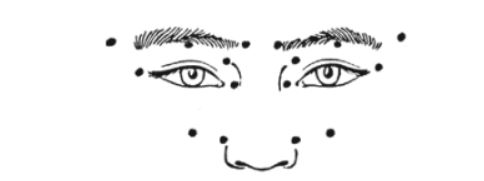
9th Technique: Relax your neck to reduce eye strain
Severe eye strain may result from tension in the neck and shoulders. Below are special exercises for relaxing the collar area. If you do them several times a day, they will help you reduce eye and neck tension and relieve headaches caused by increased eye pressure.
An effective cervical relaxation technique
1. Perform circular rotational movements with your head (Fig. 3.4).
2. Answer Move your head left and right as far as possible (gently and without tension).
3. Drop your head back and forth as low as you can.
4. Returning to the starting position, raise your shoulders as if trying to reach your ears with them, and rotate your head from left to right and right to left several times. This movement removes tension in the cervical vertebrae and trapezius muscles. By doing this exercise for one to two minutes, you will eventually feel invigorated and rested.
Circular rotation of the head, relaxing the neck, and relieving eye strain
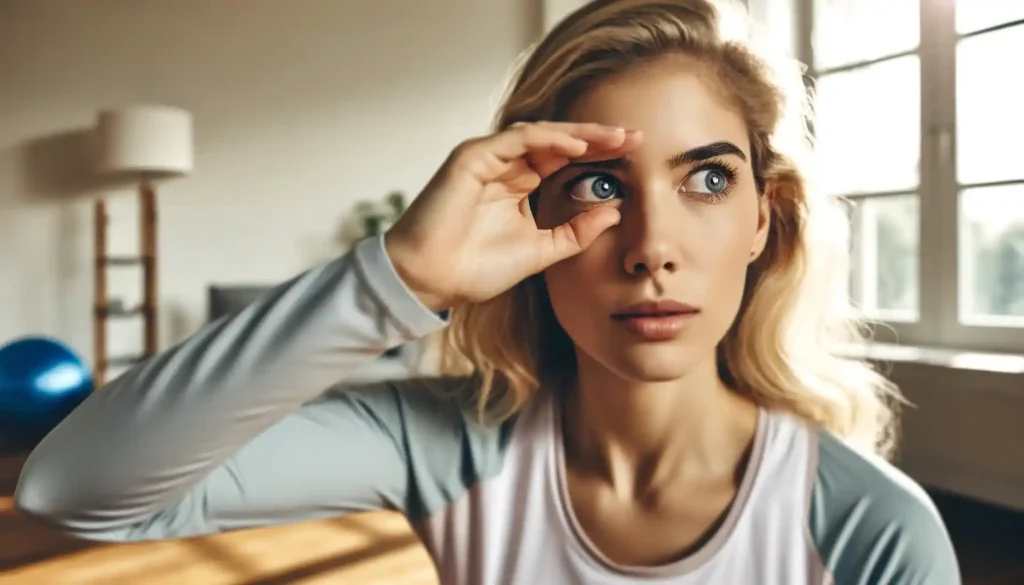
10th Technique: Taoist eye massage techniques Do-In to Enhance Sight
Eastern Taoists and Zen masters practiced a form of self-massage called Do-In. These are techniques for working with qi energy in combination with qigong breathing exercises. It is designed to improve the health of the physical, mental, emotional and spiritual spheres – to harmonize all levels of our being with the rhythm of the Universe. Daily practice of Do-In will help you achieve balance and harmony in your life and allow you to always remain centered, grounded and focused.
Massage techniques Do-In
Massage technique 1: Scalp massage
Sit up straight, relax your body and mind. Using small circular movements, massage your scalp for thirty to sixty seconds (Fig. 3.5). This massage cleanses the heart of toxins, relaxes the brain, calms the nerves, tones the scalp and improves vision by stimulating blood circulation in the head and eyes. It will be better if a loved one or friend gives you a head massage. This will enhance the relaxing and calming effect of the procedure.
Scalp massage relieves stress and tension
Massage technique 2: Eye massage with palms
1. Slightly closing your eyes, massage your eyelids above your eyeballs with your palms. Make sixteen circular movements clockwise and the same in the opposite direction (Fig. 3.6).
2. Then place your palms on your eyes and massage them up and down sixteen times and the same number from side to side.
Location of massage points
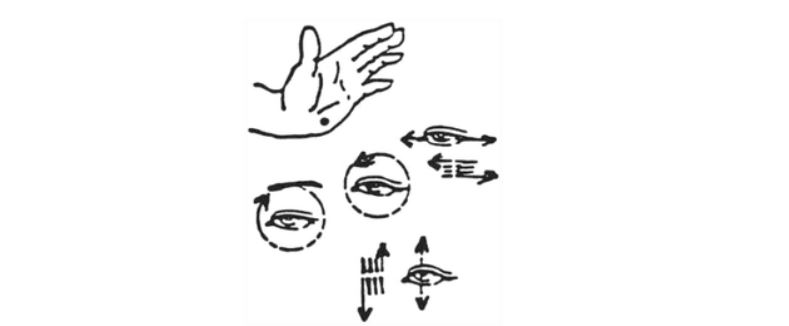
As my (Manteka Chia) experience shows, this massage technique is the best means of treating and preventing all eye diseases: myopia, farsightedness, astigmatism, as well as diseases that develop in middle and old age.
Massage technique 3: Eyebrow massage
Place the thumbs of both hands on your temples and run the second knuckle of your index fingers across your eyebrows. Repeat this movement sixteen times. Close your eyes and apply gentle pressure to your eyelids at the same angle. This exercise helps improve clarity of vision, regulates the innervation of the eyes and is a prevention of atherosclerosis and degenerative eye diseases.
Massage technique 4: Smoothing (massage option) of the face
Rub your face with your palms in a circular motion, starting from the forehead, moving down to the chin, and then up to the ears. Sixteen times in total. Chinese Taoists call this technique “Face Smoothing.” With its help you can smooth out wrinkles, stimulate the flow of fresh blood to the eyes and improve your complexion.
11th Technique: Shut your eyes firmly, then widen them as much as possible.

This Taoist technique stimulates blood circulation in the eyes, prevents tearing, and strengthens the eyelids and the muscles that regulate the tear glands. The tear glands produce a fluid that cleanses the eyes and gives them a radiant shine.
To cleanse the liver and calm the nervous system, you should pronounce the healing sound “sh-sh-sh-sh-sh-sh-sh” (we will talk about using this sound to treat the liver in the fifth chapter). If you exhale this sound and open your eyes wide, you can relieve emotional irritability and tension in the liver and eyes.
Exercise Instructions
1. Take a deep breath and slowly close your eyes for ten to fifteen seconds.
2. Then exhale slowly, making the sound “sh-sh-sh-sh-sh-sh-sh”, and opening your eyes wide. Repeat the exercise three to six times. Rule 12:
12th Technique: Naturopathic eye massage
This massage technique was used in the 19th century by naturopaths and health practitioners as a means to improve vision and prevent eye diseases.
Massage Instructions
1. Place the palms of both hands on the hard ridges of the eye sockets above the eyes. Press firmly on your eyebrows and pull the skin up, and down, to one side and the other, and then massage them in small circular motions. Perform each cycle twelve times.
2. Place your palms to your temples. Massage your skin using up-down, back-and-forth, and then circular motions. Perform each cycle twelve times.
3. Place your fingers on your cheekbones (under your eyes), then massage your skin up and down, left and right. Twelve times in total.
If you perform this massage correctly, you will be convinced that with its help you can really restore and improve your vision.
13th Technique: Outlining the contours of objects is the secret of eagle vision
Do you want your vision to be sharp and clear? Would you like to preserve the health of your eyes until you are fifty, sixty, seventy, or more years old?
It is generally accepted that after forty years we gradually lose the ability to focus on close objects, since the lens thickens due to age-related changes in the eyes. Why, then, can myopics over seventy years of age read small print freely at a close distance from the eyes? How do “experts” explain this phenomenon? The real reason for the deterioration of distance and near vision actually lies in the fact that we either never knew how to focus or have forgotten how to focus. Dr. Bates called the skill of focusing “central fixation.” When your eyes lose their ability to focus, you develop a habit of staring, staring at objects, and squinting your eyes in an effort to “focus.” This is a very bad habit that can further aggravate vision problems.
We see best when light rays fall directly on the macula of the retina. A technique called “contouring” or “contouring” by modern vision training pioneers helps restore the eyes’ natural ability to focus light on the macula. This technique involves tracing the outer contours of an object with your eyes.
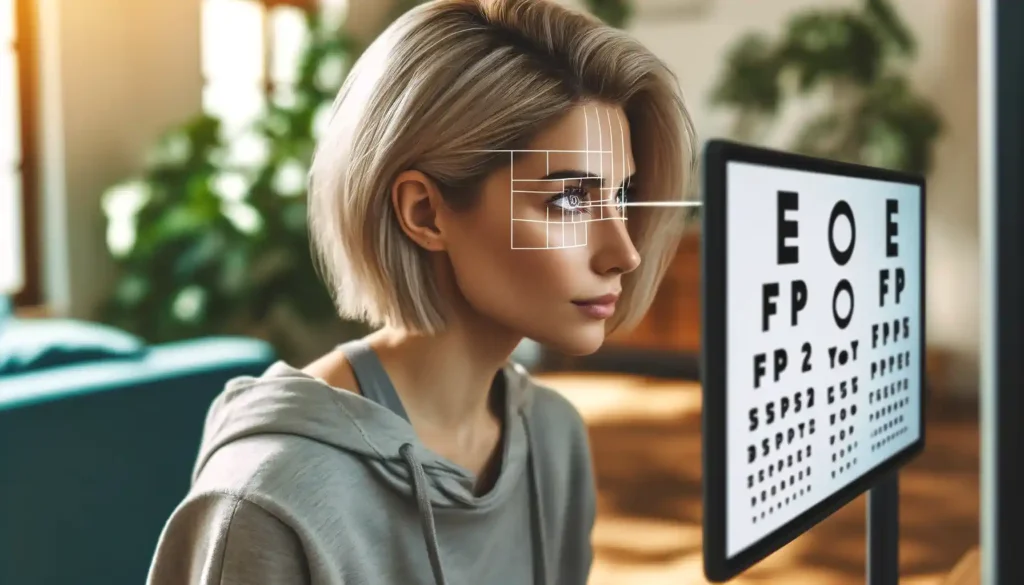
Eye Exercise Instructions for myopia to improve distance vision
To improve your ability to see into the distance, outline with your gaze an image or large letter on a sign that you can see clearly. Scan the outer contours of distant buildings, signs, billboards, or road signs. Walk your eyes along the outer perimeter of window frames, houses and trees. First, trace the object slowly, feeling each part of the outline with your eyes. Later, when you have already achieved certain results, you can increase the speed of contouring. Over time, you will begin to see objects more clearly and clearly. Practice this technique outside. Sunlight allows you to see everything better.
You can outline objects with just your eyes or use your nose as a sight. This will help you relax your head and neck, which will prevent eye muscle tension. Point the tip of your nose at the selected object and begin to trace the contours of this object.
Remember that during this exercise you need to breathe deeply and calmly. You can practice it at any time: while walking, looking out of the window, reading or doing any other activity. After completing the exercise, close your eyes. Let them rest. You can also outline objects with your eyes closed, imagining them from memory. If you want your vision to become like an eagle, practice the above technique often.
Important information on vision training. Outlining the contours of observed objects is one of the most effective eye health techniques that I (Mantak Chia) have learned in thirty years of searching for ways to achieve ideal vision.
Eye Exercise Instructions for farsightedness to improve near vision
1. To restore your ability to see at close range, trace the outlines of the letters of the printed text with your eyes: slowly trace the outer and then the inner outlines of the letters with your gaze.
2. Each week, move on to smaller and smaller letters until you can easily read the smallest print.
3. During this exercise, periodically close your eyes for several seconds.
14th Technique: Raising your head is a remedy for solving problems with vision and hearing
Raising your head is an incredibly effective exercise for eliminating hearing and vision problems. It also helps relieve headaches and pain in the neck and shoulders.
Exercise Instructions
1. Place the fingers and palms of both hands around your neck.
2. Then raise your head with your hand up and a little forward and turn it to the right.
3. After this, raise your head in the same way and turn it to the left.
With this simple exercise, you will relieve pinched nerves in your neck and relax your trapezius muscles. You should raise your head very gently and carefully so that a sudden movement does not provoke compression of the cervical vertebrae. Turn your head as far as possible, but smoothly and without tension. Do this exercise several times a day, especially before bed.
15th technique: Neck and Shoulder Self-Massage for Eyesight Recovery Guide
The incidence of eye strain and related vision issues has seen a significant rise. Alongside traditional methods to alleviate eye strain, such as reduced screen time and medical interventions, alternative therapies like self-massage have gained popularity for their potential to aid in eyesight recovery. Focusing on neck and shoulder self-massage, this comprehensive guide outlines techniques aimed at improving circulation, reducing tension, and ultimately supporting eyesight recovery.
Understanding the Connection: Neck, Shoulder, and Eyesight
The human body is a network of interconnected systems where tension or discomfort in one area can affect another. The neck and shoulders are common sites for the accumulation of stress and tension, which can contribute to poor circulation and reduced nerve function. This, in turn, may impact eyesight since optimal blood flow and nerve function are crucial for healthy eyes. Relieving tension in these areas through self-massage can thus indirectly support eyesight health.
Preparing for Your Self-Massage
Before beginning your self-massage routine, it’s essential to prepare your environment and yourself to ensure maximum benefits:
- Warm Up Your Hands: Rub your hands together or wash them in warm water to make sure they’re warm before starting the massage.
- Use Massage Oils (Optional): While not necessary, applying a small amount of massage oil can help reduce friction and enhance relaxation.
Self-Massage Techniques
1. Neck Release
- Technique: Sit or stand comfortably. Gently tilt your head to one side, bringing your ear closer to the shoulder until a stretch is felt on the opposite side of your neck. With the hand on the same side as the tilt, gently massage the neck muscles, using a combination of small circular motions and gentle kneading. Repeat on the other side.
- Duration: 2-3 minutes per side.
- Benefits: Relieves tension in the neck muscles, promoting better circulation and nerve function to the head and eyes.
2. Shoulder Squeeze
- Technique: Reach across your chest with one hand to grasp the opposite shoulder firmly. Squeeze the shoulder muscles gently but firmly, then release. Work your way across the shoulder and up to the neck with small kneading motions.
- Duration: 3-5 minutes on each shoulder.
- Benefits: Releases muscle knots and tension in the shoulders, facilitating improved blood flow to the cervical spine and head.
3. Scalp Massage
- Technique: With fingertips, begin at the forehead hairline and make small circular motions, gradually working your way over the entire scalp to the nape of the neck.
- Duration: 5-7 minutes.
- Benefits: Stimulates nerve endings and blood circulation in the scalp, indirectly benefiting eyesight by promoting relaxation and reducing eye strain.
4. Eye Surround Massage
- Technique: With clean hands, gently massage the temples in circular motions, then move to the area under the eyes and the bridge of the nose with gentle outward strokes.
- Duration: 2-3 minutes.
- Benefits: Helps reduce eye strain and tension headaches, promoting relaxation and potentially aiding in eyesight recovery.
Safety Tips and Considerations
- Gentle Pressure: Always use gentle pressure to avoid bruising or discomfort.
- Avoid Direct Eye Contact: Be cautious not to press directly on your eyes.
- Consistency is Key: Regularity in performing these massages can yield better results.
- Seek Professional Advice: If you have existing neck, shoulder, or eye conditions, consult a healthcare professional before starting a self-massage routine.
Conclusion
While self-massage techniques focusing on the neck and shoulders can offer benefits in relieving tension and supporting overall well-being, they should be seen as complementary to traditional eyesight recovery methods. Embracing a holistic approach that combines self-massage with proper eye care, regular breaks from screen time, and medical advice can offer the best strategy for maintaining and recovering eyesight health.
Neck and shoulder massage Do-In
In addition to head elevation, it is also recommended to perform Do-In massage or self-massage of the neck and shoulders with your fingers, knuckles, and palms. If you have pain or tightness in your neck and shoulders, massage them to open up renewed energy and fresh blood to your head, brain and eyes. Without sufficient energy and a good blood supply to the eyes, it is impossible to achieve a stable improvement in vision. Congestion in the neck and shoulder area can truly become a serious obstacle to excellent vision. And in solving this problem, the “Head Raising” exercise has no equal.

